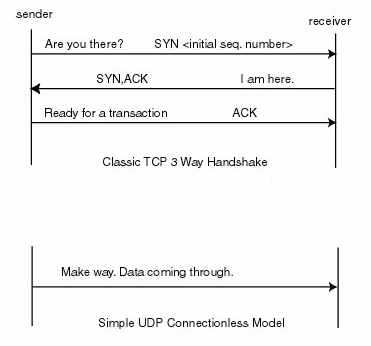
Figure: Connection-oriented and connectionless data transmission examples.
izvor: http://www.oreillynet.com/pub/a/network/2001/07/13/net_2nd_lang.html?page=2
| TRANSPORT |
|
Višeslav Račić |
|
Figure: Connection-oriented and connectionless data transmission examples. izvor: http://www.oreillynet.com/pub/a/network/2001/07/13/net_2nd_lang.html?page=2 |
|
The transport layer of the OSI Network model, Layer 4, is the layer that makes client-server applications a reality. In Layer 3, we looked at routing functionality. Now we need to consider an intermediate layer between routing and a computer application. A simple server operating inside a corporate Intranet can be configured to carry out many functions. The server could be running Apache web server software, an FTP server daemon, a mail server daemon, and so forth. There are many applications running simultaneously on one high-end, very expensive server. How is it then when a user launches an FTP application and merely types in an IP address that a directory on a remote server magically appears? The user only specified an IP address of a remote server to download from. The IP packet certainly has no information in its header regarding the type of service required. Is there some hocus-pocus going on, or is there a protocol that is assisting applications? We're going to examine a special protocol suite, Transmission Control Protocol over IP protocol (TCP/IP), that does exactly this. TCP and UDPComputer bookstore shelves are stacked floor to ceiling
with books on the TCP/IP protocol suite. Like the OSI Network Reference
seven-layer model, TCP/IP suite outlines a model for several protocols at
different layers. The TCP/IP protocol suite is a four-layer model that
closely resembles the OSI model. The lowest layer, Layer 1, is the link
layer which is identical to the OSI datalink layer. Layer 2 of the TCP/IP
suite, is the network layer. Layer 3 is the transport layer and Layer 4 is
the application layer. There is some degree of confusion when first learning this suite. Under the OSI Model, TCP and UDP are Layer 4 protocols. Under TCP/IP, they are Layer 3 protocols, which is now the transport layer. To muddy things up a bit further, there are two distinct protocols operating at the transport layer. They are Transmission Control Protocol (TCP) and User Datagram Protocol (UDP). UDP is a part of the TCP/IP suite and it behaves significantly different from its transport layer cousin, TCP. TCP and UDP transport layer protocolsThe primary distinction between TCP and UDP lies in how each protocol behaves. TCP is a complex protocol that provides connection-oriented reliable features to the application layer. Once data is handed off from the application layer to the transport layer, using TCP as the transport protocol, the application also hands off flow control to the lower layer. TCP will use its built-in messaging mechanisms to ensure the application data makes it to the destination device. UDP is a connectionless and unreliable transport-layer protocol. The UDP protocol is extremely simplistic in nature. Data from the application layer is handed down to the transport layer and encapsulated in a UDP datagram. The datagram is sent to the host with no mechanisms to guarantee the safe arrival on the destination device. This checking is pushed back up to the application layer if reliability is desired. |